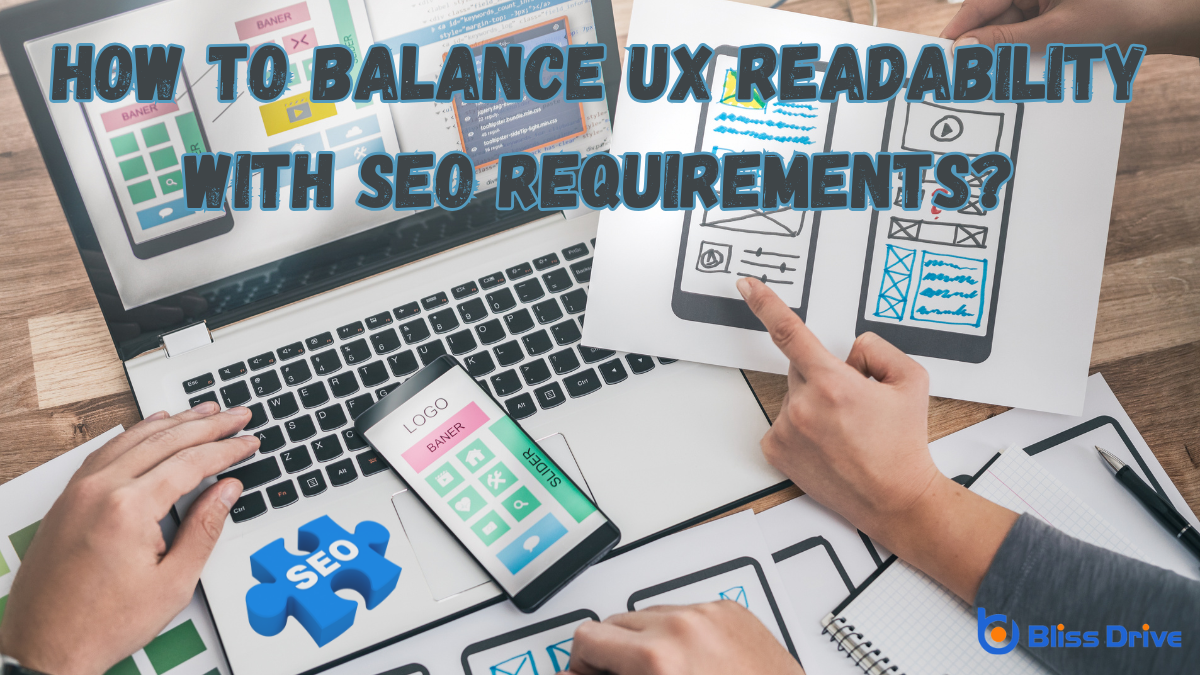Learn More About Us

To balance UX readability with SEO requirements, focus on intuitive design and meaningful keyword integration. Use clear language and user-friendly layouts while identifying target keywordsWords or phrases that users type into search engines to find information. that match your audience's needs. Avoid keyword stuffingOverloading a page with keywords to manipulate search engine rankings. and keep sentences direct and engaging. Break up text with headers, bullet points, and multimedia for better readability. Regularly monitor performance using tools like Google AnalyticsA web analytics service offered by Google that tracks and reports website traffic. to make informed decisions. Explore further to enhance your site's digital experience.
While diving into the world of digital design, it's crucial to grasp the fundamentals of UX (User Experience) and SEO (Search Engine Optimization)The process of improving the visibility of a website on search engines via organic search results.. Understanding UX means focusing on how users interact with your website. You want them to navigate effortlessly, appreciate the content, and ultimately achieve their goals. This involves intuitive design, clear language, and user-friendly layouts.
SEO, on the other hand, guarantees your site ranks well on search engines like Google. It involves optimizing content, metadataData that provides information about other data, such as its source, format, and usage., and site structure to improve visibility.

You can't underestimate the importance of keyword research in balancing UX readability and SEO.
Start by identifying target keywords that align with your audience's needs and analyzing their search intent to guarantee your content meets expectations.
Don't overlook long-tail keywords; they often bring in highly targeted traffic and can enhance user engagementThe level of interaction and involvement users have with social media content..
How do you guarantee your content reaches the right audience in a sea of information? Identifying target keywords is vital. You need to understand what terms your audience uses when searching for content like yours.
Begin by brainstorming words and phrases relevant to your topic. Then, use keyword research tools to analyze their search volume and competition. Look for a balance—keywords with high search volume but low competition are ideal.
Don’t just guess; data-driven decisions will guide you toward the right choices. Remember, target keywords should align with your content’s intent and your audience’s needs.
Why does understanding search intent matter in keyword research? It’s essential because it helps you align your content with what users are genuinely seeking. When you grasp search intent, you can choose keywords that match the user's needs, whether they're looking to learn something, find a specific site, or make a purchase. This alignment guarantees that your content satisfies their queries, leading to better engagement and higher rankingsThe position at which a website appears in the SERP..
To analyze search intent, look beyond mere keywords. Consider the context and the type of content that usually ranks for those terms. Are users expecting detailed guides, quick answers, or product comparisons?
Analyzing search intent provides a strong foundation for understanding user needs, and this understanding extends directly into the effective use of long-tail keywords.
You see, these keywords are more specific phrases that your audience searches for, often when they're closer to making a decision. By including long-tail keywords, you’re tapping into less competitive, highly relevant search traffic.
This approach doesn’t just boost your SEO; it aligns content with user intent, enhancing readability and engagement.
Imagine a potential customer searching for “best eco-friendly yoga mats for beginners.” Using such specific phrases helps you match their precise needs, making your content more likely to resonate.
Plus, you’ll attract users who are more likely to convert, as their search intent is highly targeted.
While crafting content, it’s essential to strike a balance between engaging storytelling and readability. You want your audience to connect emotionally while clearly understanding your message.
Start by knowing your audience. Speak their language by using simple, direct sentences that convey your ideas without confusion. Use active voice to keep readers involved and interested.
Break up large chunks of text with subheadings, bullet points, and images to maintain visual appeal.
Although it might be tempting to load your content with keywords to boost search engine rankings, doing so can actually harm your site’s performance. When you overuse keywords, search engines may flag your content as spammy, reducing your visibility.
Instead, focus on natural language that flows well and resonates with your audience.
Keyword stuffing makes your content awkward and less engaging, driving users away. Remember, search engines have evolved to prioritize user experience, understanding content context over mere keyword frequency.
Prioritize clarity and relevance over repetition. Integrate keywords meaningfully, ensuring they fit the context.

Headers and subheaders play an essential role in structuring your content, guiding both readers and search engines through your material. They help break down information into digestible sections, making it easier for users to find what they need quickly.
By using clear and descriptive headers, you improve user experience and make your content more inviting.
Search engines also benefit from well-organized headers, as they use them to understand your content’s hierarchy. When crafting headers, use relevant keywords naturally without overdoing it.
This strategy supports SEO by signaling the main topics of your content while keeping it readable.
When it comes to enhancing readability, a few simple formatting techniques can make a significant difference.
By organizing your content visually, you help readers process information efficiently and enjoyably. Here are a few strategies you can use:
Applying these techniques will certainly improve how your audience engages with your content.
To capture and retain your audience's attention, integrating multimedia elements like images, videos, and infographicsVisual representations of information, data, or knowledge intended to present complex information qu... can be incredibly effective.
These tools break up text, making your content more visually appealing and easier to digest. When you use images, make sure they’re high-quality and relevant to the topic.
Videos can illustrate complex ideas and keep users on your page longer, reducing bounce rates and boosting SEO. Infographics present data visually, helping readers grasp information quickly.
Remember to optimize all multimedia elements for fast loading times and add alt textDescriptions added to images to help search engines understand the content of images. to images for accessibility and SEO benefits.

While crafting content that's both engaging and optimized for search engines, implementing effective internal and external linkingLinks that point to external websites from your site. strategies is crucial. Internal links connect different pages on your website, guiding users through related content and helping search engines understand your site's structure.
External links, on the other hand, connect your content to credible sources, further enhancing your site's authority. To effectively implement these strategies, consider the following:
Crafting a robust linking strategy is only part of the journey towards optimizing your website for both user experience and search engines.
To truly excel, monitor and analyze user behavior and SEO performance. Tools like Google AnalyticsThe systematic computational analysis of data or statistics to gain insights and support decision-ma... and Search Console offerThe specific product or service being promoted by affiliates. insights into how visitors interact with your site. Look at metrics such as bounce rates, session duration, and conversionThe completion of a desired action by a referred user, such as making a purchase or filling out a fo... rates. These tell you if your content engages users or needs improvement.
SEO performance analysis is essential, too. Track keyword rankings and organic trafficVisitors who come to a website through unpaid search engine results. trends to guarantee your strategies align with search engine requirements.
Regularly reviewing these analytics helps you make informed decisions, adjusting content and SEO tactics as necessary. Stay agile; understanding user behavior and SEO performance keeps your site thriving and relevant.
Balancing UX readability with SEO requirements isn't as tricky as it seems. By focusing on user-friendly content and smart keyword use, you’ll enhance both user satisfaction and search rankings. Use headers, subheaders, and formatting to guide readers, and incorporate multimedia for engagement. Avoid keyword stuffing and maintain a natural flow. Regularly monitor user behavior and SEO performance to refine your strategy. With these steps, you’ll create content that’s both readable and optimized.
